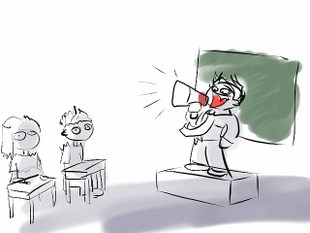TPE 1: Specific Pedagogical Skills for Subject Matter Instruction
|
Strategies
Teachers uses different skills and strategies to ensure that students learn the materials they should be learning. Concepts for young children are often force taught in one method and that one method is usually direct instructions. Direct instruction is where the teacher is in front of the class and verbally explaining to the students what they should be learning. While direct instructions is not a bad method, it should be compounded with other strategies to ensure that students are engaged and always evaluating the purpose and meaning of the content learning through other means. This constant cycle will induce a realization that their learning in school is connected to learning in real life. Language Arts : Silent-e for 1st Graders For first graders, learning to read is a huge issue in their life. Being able to decode and translate words from books to verbal speech is an enormous accomplishments and a proud skill they are willing to share to others. Erik Erikson's Stages of Development has children in first grade as students who love to mimic adults and are at the phase of their life where the importance of play is for the purpose of learning is ending and the beginning self-worth in the society is starting to arise. Using the theory of Erikson, I have managed to create a lesson in which play-based learning is connected with the learning of one of the hardest concept children of that age range can learn: the silent-e. In kindergarten, children are introduced to the most basic format of reading: consonant letter - vowel letter - consonant letter (CVC). This format is excellent for phonetic reading as each letter correspond to a sound. However, the children should be eventually introduced to learning patterns of letter combination and sounds. This recognition is often refered to as family words and deals with all the short vowel sounds. Silent-e is the next step in learning a word pattern. Students who now thought that each word correspond to only one sound will find that they are in fact wrong. This notion of them being wrong frustrates a lot of children because they refuse to accomodate prior knowledge with this new concept and knowledge. However, repeated instruction and activities will help students ease into learning the patterns of words. Part of play based learning is feeding off children's natural own curiosity and imagination. This also requires that the teacher be actively involved with the role-playing and filling the child's world of imagination. Despite that the children are living a fantasy learning base world, the students will make use of their environment to set the play stage. The teacher's duty now is to surround the students with literacy and understand that what they are learning is concrete and practical for the students. |
| CA- CCTC: TPE's (Teaching Performance Expectations) |
| Standard : A. Making Subject Matter Comprehensible to Students |
| TPE : TPE
1: Specific Pedagogical Skills for Subject Matter Instruction TPE 1 is divided into two categories intended to take into account the differentiated teaching assignments of multiple subject and single subject teachers. Multiple subject credential holders work in self-contained classrooms and are responsible for instruction in several subject areas; single subject teachers work in departmentalized settings and have more specialized assignments. These categories are Subject-Specific Pedagogical Skills for Multiple Subject Teaching Assignments (1-A), and Subject-Specific Pedagogical Skills for Single Subject Teaching Assignments (1-B). |
| Component : TPE 1A: Subject-Specific Pedagogical Skills for Multiple Subject Teaching Assignments |
|
Standard Area : Teaching
Reading-Language Arts in a Multiple Subject Assignment Candidates for a Multiple Subject Teaching Credential demonstrate the ability to teach the state-adopted academic content standards for students in English-Language Arts (K-8). They understand how to deliver a comprehensive program of systematic instruction in word analysis, fluency, and systematic vocabulary development; reading comprehension; literary response and analysis; writing strategies and applications; written and oral English Language conventions; and listening and speaking strategies and applications. They know how to strategically plan and schedule instruction to ensure that students meet or exceed the standards. Candidates create a classroom environment where students learn to read and write, comprehend and compose, appreciate and analyze, and perform and enjoy the language arts. They understand how to make language (e.g., vocabulary, forms, uses) comprehensible to students and the need for students to master foundational skills as a gateway to using all forms of language as tools for thinking, learning, and communicating. They understand how to use instructional materials that include a range of textual, functional and recreational texts and how to teach high quality literature and expository text. They understand that the advanced skills of comprehending narrative and informational texts and literary response and analysis, and the creation of eloquent prose, all depend on a foundation of solid vocabulary, decoding, and word-recognition skills. Candidates teach students how to use visual structures such as graphic organizers or outlines to comprehend or produce text, how to comprehend or produce narrative, expository, persuasive and descriptive texts, how to comprehend or produce the complexity of writing forms, purposes, and organizational patterns, and how to have a command of written and oral English-language conventions. They know how to determine the skill level of students through the use of meaningful indicators of reading and language arts proficiency prior to instruction, how to determine whether students are making adequate progress on skills and concepts taught directly, and how to determine the effectiveness of instruction and students’ proficiency after instruction. |

